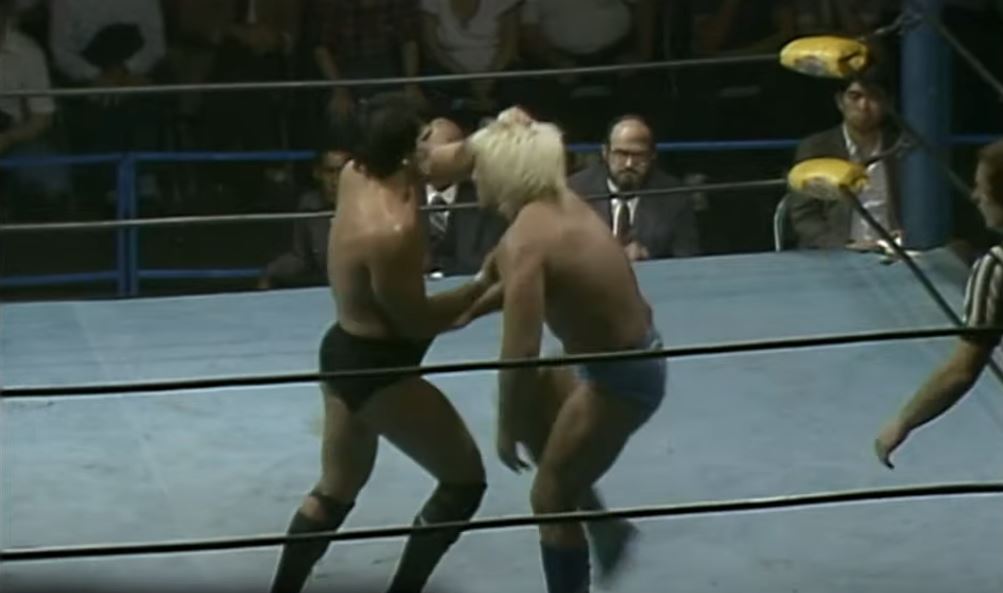This is about traffic lights in psychology, biology, science fiction, Tibetan Buddhism, history, and contemporary art to better understand “what is going on” with this other-than-human character in Twin Peaks.
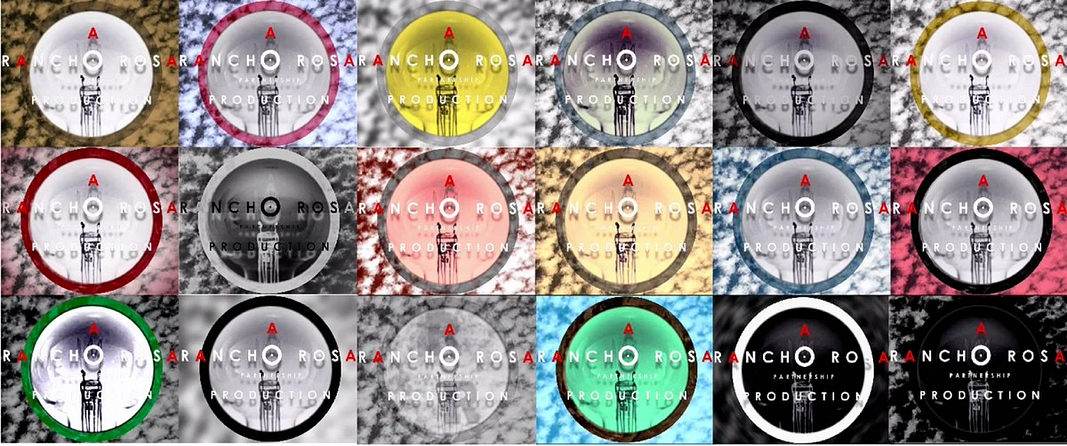

The signal stretches and refracts in other ways, like how a green light flashes onto Anthony’s face in Part 5, or if you blur your eyes, the Evolution Of The Arm kind of looks like a traffic light, especially when it’s yelling “Go now! Go now!” from atop its tree in Part 2. Isn’t its doppelganger yellow? Additionally, a Woodsman acts like a traffic light in the floral wallpaper room in Part 15, moving from one position to another to let Mr. C go through to the Duchman’s. He’s directing traffic, and in this sense, oh my goodness, Bobby Briggs in Part 11—also a traffic light! He’s the receiving end of that woman screaming from her car to let her go through. “We’re late!”
And let’s not forget that scene in Part 2—what one critic called “a great echo of the old series’ shots of a stoplight…turned into a rattling, noisy hell beast”—when we wait and wait at the train crossing light, and we hear the train screaming in our ears long before we ever see it. Is this a metaphor for the show itself?
It’s not until Part 6 that the original stoplight from the pilot properly returns, and there’s this holy sh*t moment, it changes from yellow to red, and Redditor kaleviko points out that in the very next scene when Cooper is working on his case files, his pencil changes from yellow to red due to a continuity error. (Thank you IamDeadYetILive for that connection). I wonder if DuWayne Dunham for fun edited in the traffic light to draw attention to the error. The Return is full of them continuity errors.
Error? In art we should honor errors as hidden intentions (Eno). Tangentially, Richard Horne’s car is both red and green which has got to mean something, so John Bernardy thinks it suggests “the story is going through him.”
Finally, in Laura Palmer/Carrie Paige’s house in Part 18, an isolated picture on the wall resembles a traffic light, and just in case we weren’t paying attention, beneath it are three stacks of toilet paper; three TPs. (Laura and Bobby used to call Twin Peaks “TP” as a joke in The Diary). This all seems very deliberate, especially when we consider that there are echoes of all our favorite Twin Peaks symbols in and around this woman’s house in Odessa. #6 Telephone Pole is right outside!
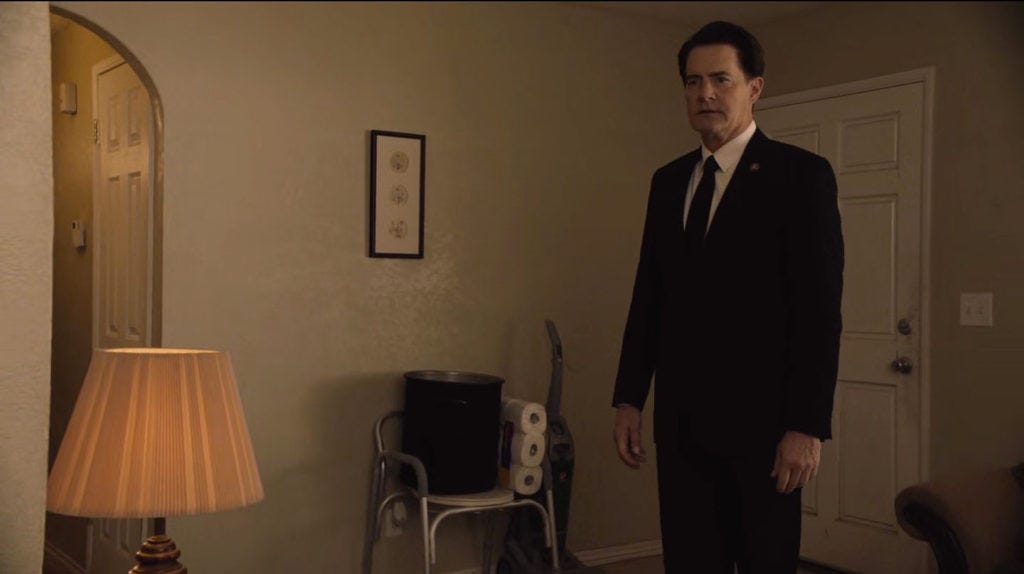
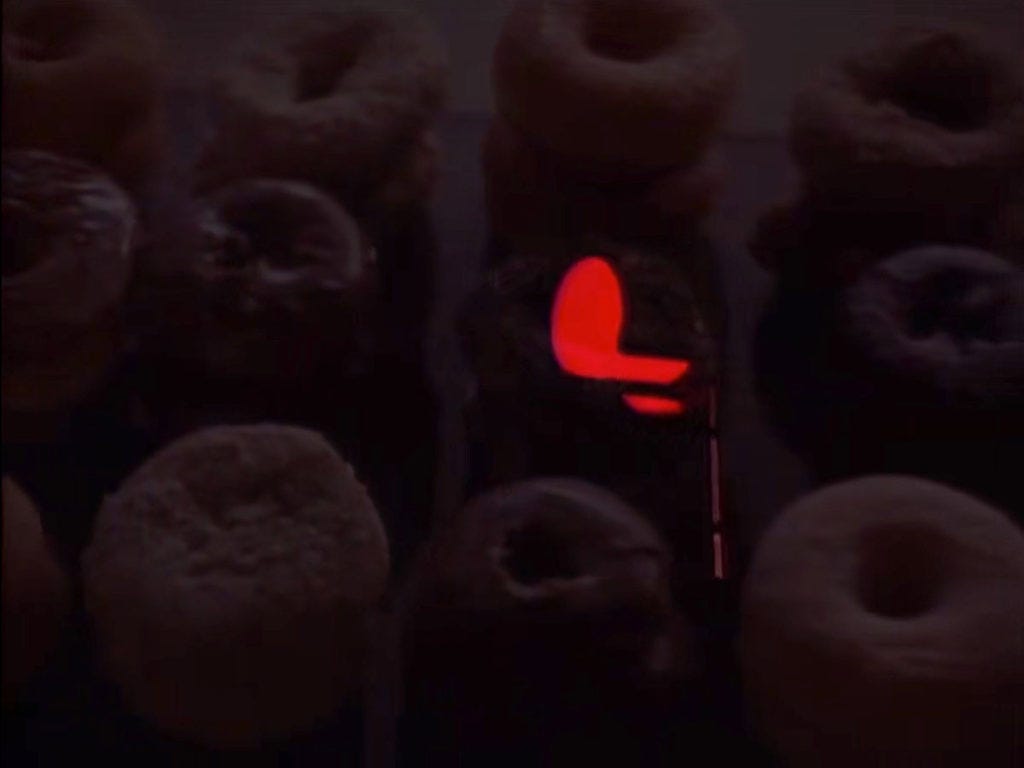
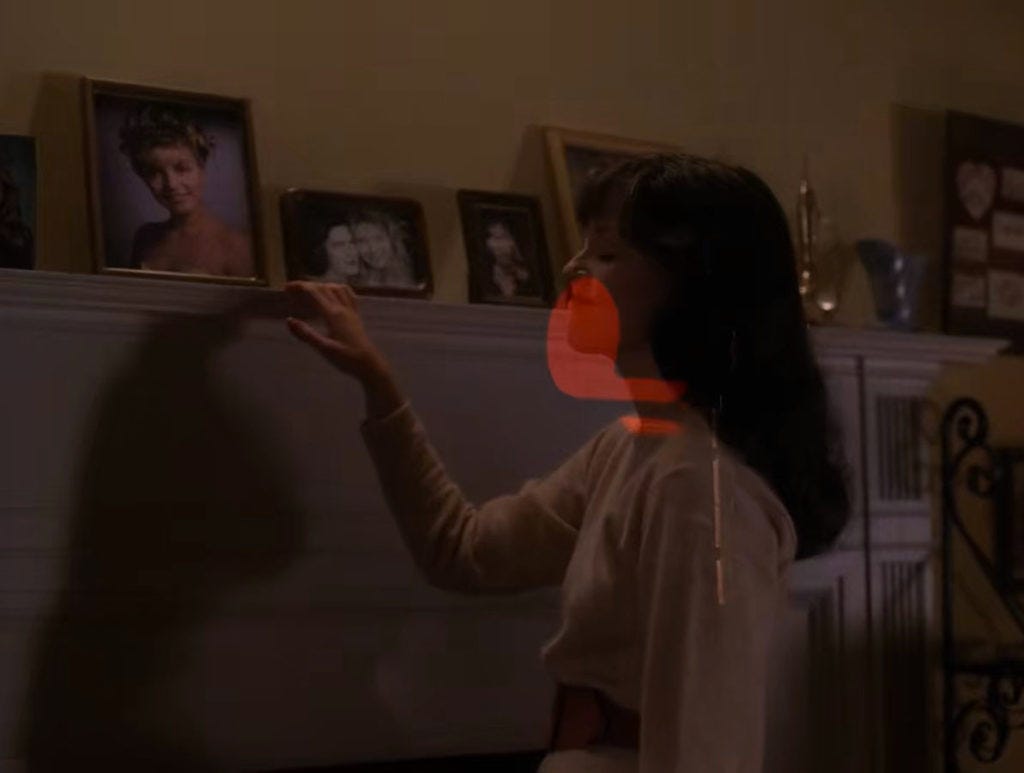
Origins
In the pilot, the traffic light appears next to its cousin, the ceiling fan, another signal from above telling Leland, “You can go in now.” At the beginning of Season 2, it’s superimposed over images of donuts when Cooper “lays it all out” at the Sherrif’s Station, and a few episodes later, it fades into Maddy’s head when she’s looking at Laura’s homecoming picture and talking with Leland—foreshadowing her death. I’m getting these still shots from Steven Miller’s Setting the Stage. Miller points out that one of the reasons the light is emblematic of the show—like the homecoming picture, coffee and donuts—is because it appeared on promotional materials and VHS cases in the 1990s. And hell, if I didn’t know better, just looking at these cases I’d think the light was the star of the show!
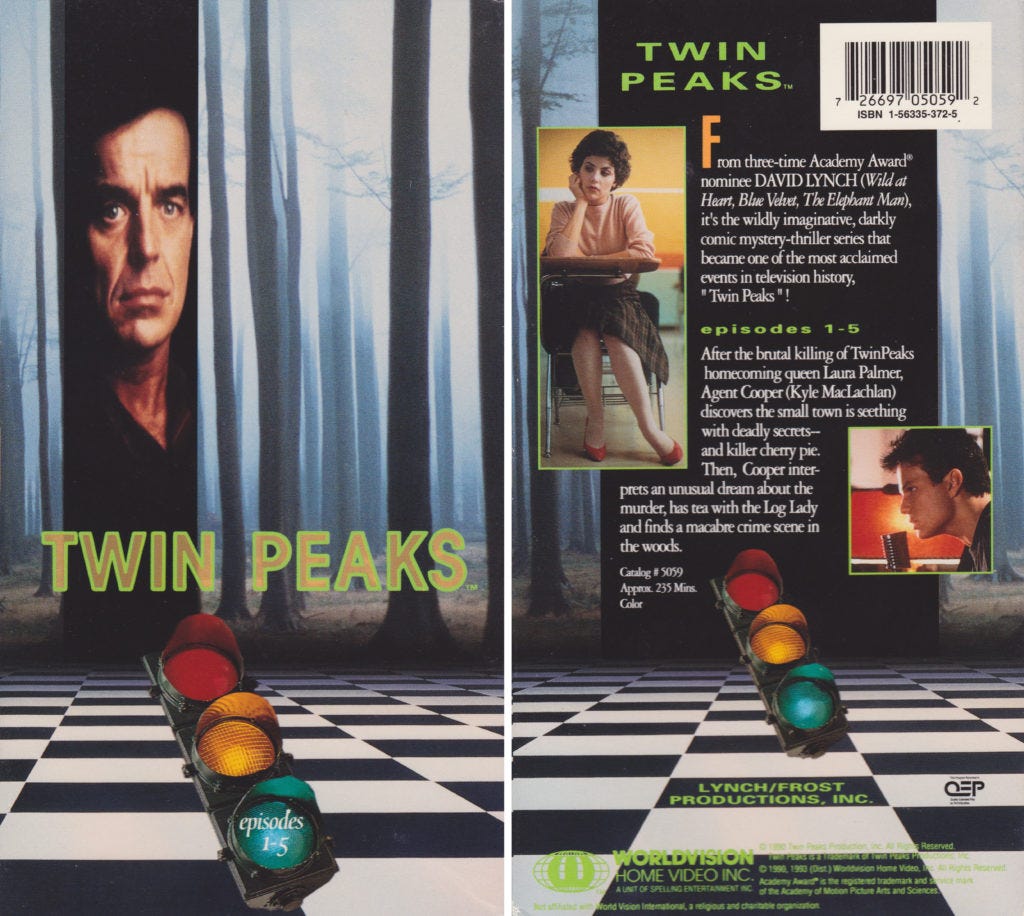

It’s also hanging there at the opening of the original 1988 script. Greg Olsen in Beautiful Dark (2008) says it was Frost who came up with the traffic light scenes in the pilot, probably as a nod to Lynch’s use of them in Blue Velvet. Why exactly do Lynch and Frost like this image so much?
It could have something to do with the children’s game Red Light Green Light (also known as Statues) that’s been around for over a hundred years. It’s everywhere; it’s foundational; fundamental fun; and as philosopher Roland Barthes points out, children’s games prefigure the world.
Both Lynch and Frost had experiences with this game and also probably participated in a milk-drinking game called Red Light Green Light featured on the TV show Cartoon Express that ran from 1954 to 1966. Its creator and host, “Engineer Bill” William Stulla won two Emmy Awards for the show, where kids at home could compete and win against the host on TV! It’s so interactive. Alas, one elder remarks, “I think the moment of reaching adulthood is when we realized he had been letting us win.” Strangely, the Engineer is pictured with a clown and a clock.
Traffic Bombs
The point is that historically, traffic lights extend beyond the street; they even reach into the bomb. Legend has it that Leo Szilárd, the mind behind the bomb, got his idea for a nuclear reactor by watching a traffic light turn from red to green. His biographer Richard Rhodes describes what happened next:
As he crossed the street time cracked open before him and he saw a way to the future, death into the world and all our woes, the shape of things to come.
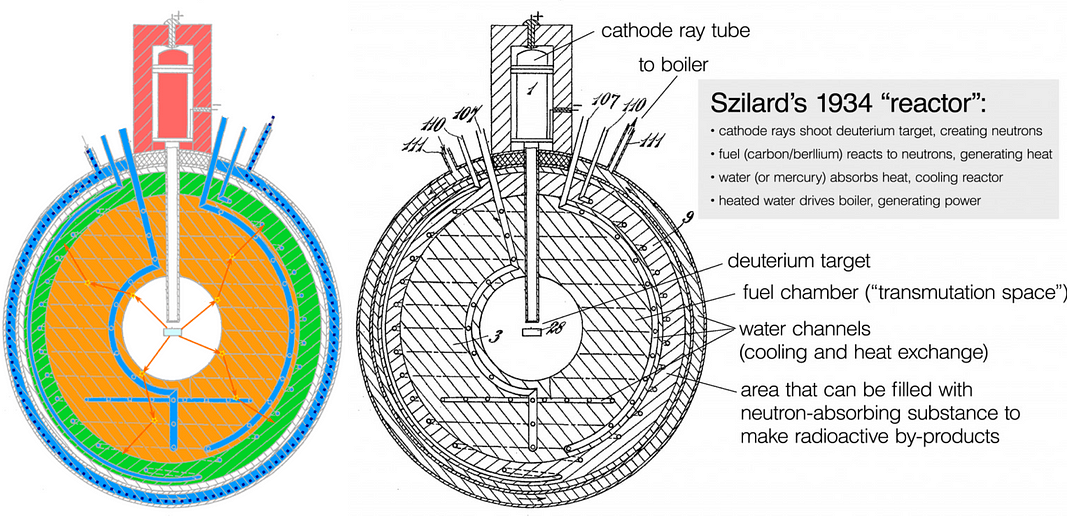
Szilard’s nuclear reactor does kind of look like a traffic light and a cherry paaaaiii! Hold up. Did the light facilitate some kind of revelation for Szilard? Did traffic lights help give birth to the bomb?
They’re within us, too: Neurobiologists insist there is a traffic light in the brain and a traffic light approach to understanding the brain. Of course, our traffic light brains manufactured traffic lights. Now we exchange ideas and change one another.
Our eyes also have three cones that can pick up three colored wavelengths, red green and blue, which is apparently the reason why traffic lights use three colors. Red, having the longest wavelength, can be seen the farthest away, affording trains—and later, cars—more time to stop on foggy nights.
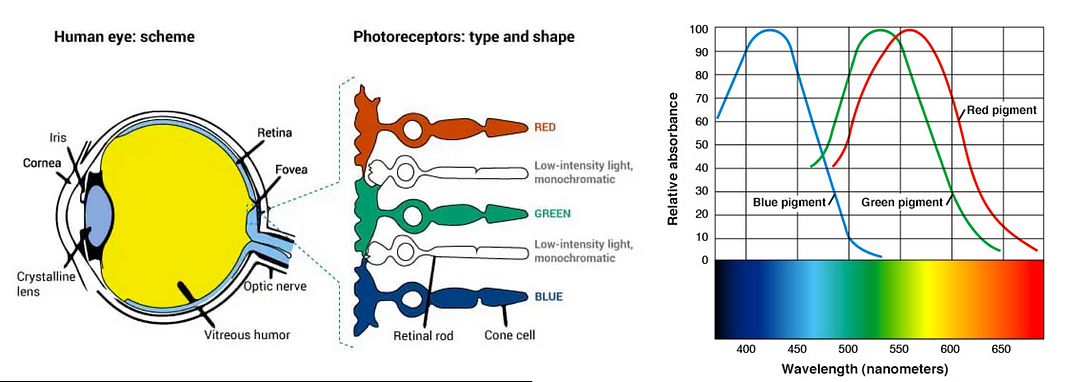
We also use traffic light metaphors—they’re “metaphors we live by”—in film production, sports, sexual harassment, eating, dieting, and childhood sexuality.
When we sit with them, they induce boredom (which has its own benefits), and, weirdly, red lights induce scratching according to psychodermatology and what’s called the traffic light phenomenon. They also kill people.
The very first one exploded and killed the policeman who was operating it, and when the automated ones were first installed in US cities in the early 1920s, people thought they were dangerous, even evil, for a number of reasons. First, because people were still dying beneath them, but also because of their impact on civility. (I’m getting this from Megan Kate Nelson’s brief history.) Drivers didn’t have to acknowledge other people at intersections anymore, the stoplight decided everything, and so the public experience of connecting with other human beings—our team!—turned into a private moment to sit alone, lost in thought.
Traffic lights quickly became what Bruno Latour and Michel Serres call quasi-objects, what Timothy Morton calls world-encircling hyperobjects, and what William Irwin Thompson calls the next alphas annunciating the next level of order—one definition of “evil.”
Marshal McLuhan would say they’re examples of a tool we shaped that now shapes us. Nelson writes that the traffic light “shaped our cities and sparked our love affair with the car itself.” In a sense, they’re not only extensions of ourselves and our brains, but of the car—itself an extension of our bodies—and of the insurance agencies with their cameras.
Every extension requires an amputation, every new technology requires a sacrifice, and so we have to wonder, what did we lose? I think it’s clear that these American, panoptic light machines installed all over the world keep everyone in control, they choreograph dangerous sites from above, and they partake in making both more dangerous. After they were installed in the 1920s, drivers became more anxious, and it became apparent that the lights produced an increase in road rage, mostly because they held up traffic (I’m getting this from A Phenomenology of Traffic in Ho Chi Minh City by Glen Wyatt). Faster and faster, people grew frustrated they had to wait at red lights, and so naturally yellow and green lights began to encourage speed, which made accidents more fatal. I understand why these new devices that encourage speed were dubbed by some critics, “the most destructive machine yet to be devised by man.”
In what we now call the US, about 20% of accidents occur at these things, nearly 165,000 of them every year by people running red lights. A thousand people in the US are killed every year from red light running. Are the lights partially to blame?
If they’re “alphas,” they’re predators. Artist-paleontologist Micheal Garfield explains that because humans killed all the predators that used to hunt us, now they haunt us from inside of modern life. It’s not just a coincidence that road rage, speeding cars, and car accidents are all recurring motifs in horror films, especially David Lynch’s horror films. Lynch/Frost point to the stoplight.
Some critics mark traffic lights as exercises in self-defeat. Twin Peaks scholar Jeffrey Weinstock calls them demonic objects. They’re viewed next to the owls and swaying branches — like they’re witnesses to the crime; like they all saw something that night and are implicated in some way. It’s spooky, but the final image of the traffic light in the pilot is sandwiched between a shot of the log on the beach where Laura’s body was found, the ceiling fan, and Sarah Palmer on the couch!
Emerson warned us that when we discard our angels, archangels take their place, and I find it interesting that to combat the invading traffic lights, some neighborhoods are retrieving what’s called shared spaces, places “where the sidewalk doesn’t end”; open roundabouts where everyone—drivers, pedestrians, and cyclists—can all safely coexist; and these angelic spaces are proving that the absence of traffic signs makes everyone more cautious! And maybe we all should revert to magical roundabouts. (See also The Roundabout Revolutions by Eyal Weizman).
This same increase in caution happens whenever the power goes out (Part 18?): people slow down, look alive, fewer people die, and it doesn’t really slow traffic down that much.
Art
Interesting fact: there is no traffic light at the Twin Peaks filming location for Sparkwood and 21, which means it was added to the scene on purpose. Hopefully, I won’t irritate you if we move on from traffic light history to traffic light art. Something happens when an elusive, world-encircling hyperobject like traffic machinery, usually pushed into the background ubiquity, gets moved into the spotlight. A new gestalt forms. Generally, when we turn any part of our environment into art, we reframe ourselves and shift into a wider, deeper perspective, what philosophers call “decentered consciousness,” one that is sensitive to new environments and can catch new ideas. It’s again as Marshal McLuhan says: “The previous environment becomes a work of art in the new invisible environment,” and this cultural and technological developmental pattern probably relates to Robert Keagan’s explanation of psychological development—that “the subject of one stage of consciousness becomes the object for the subject of the next stage.”
We can approach stoplights as readymade art objects, strange tools, and, due to the rise of self-driving car technology, they’re soon-to-be negated-yet-preserved Hyperart Thomassons (thank you Ely Fair for that one). They’re going to be like potted plants. William Irwin Thompson: “We slay with technology and save the victim with art.”
When we approach everyday things as art, or as complex magical entities in and of themselves, it’s easy to flip our perspectives, decenter the human, and see ‘material agency,’ ‘actor-networks,’ and buildings ‘breathe’ people through pathways regulated by stoplights. This alien-eye view is captured beautifully here by Ron Frick in his 1992 film Baraka. I also really like the work of artist-geographer Bill Psarras (2015) who remarks on the practical and poetic levels of a traffic light that invite us to see it as part of a larger art installation.
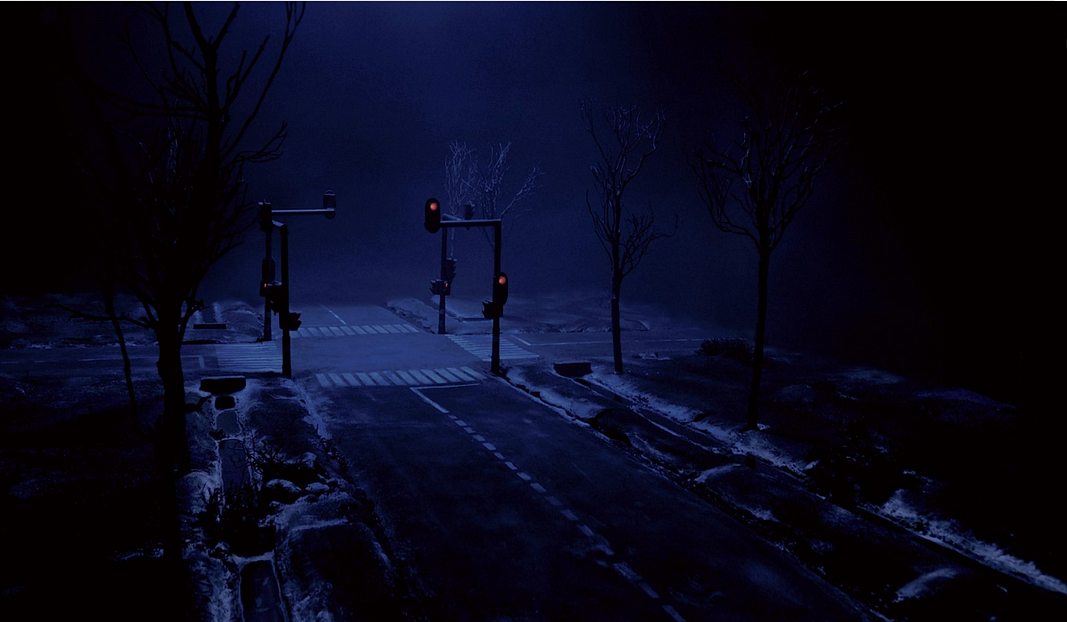

Location 1
Another artist who can help us see whole traffic light environments is Hans Op de Beeck, who builds miniature installations like Location I where we walk through the gallery doors, turn the corner, and are confronted by a dark, foggy, intersection. Due to the shift in scale, we’re positioned slightly above the street in a bird’s eye view; traffic light level. Inside is now outside. The exact edges of the artwork and viewer disappear in foggy darkness.
Silent stillness surrounds the only activity: the switching on and off of traffic lights. They pulsate. The whole image feels allegorical and sacred. In Twin Peaks and in the Op de Beek, there is a figure-ground reversal as the tiny lights draw attention to the empty space around them. Nothing else is happening. It’s like a subtly moving painting.
J.P. Tellote in his 1995 essay The Dis-order of things in Twin Peaks uses Foucault’s idea of ‘blank spaces’ and surveillance to better understand what the traffic light is doing in the show and in us. William Irwin Thompson talks more generally about the mind being like a flashlight in search of darkness, which is all around. The more it searches the more it chases it away, and if we want to see the nature of what’s going on, we have to shift from a “creative” mode to a “receptive” mode, turn off the mind, and allow the darkness to communicate with us. (See Time Falling Bodies Take To Light, 1996, 87).

Columbus Chronicles
Twin Peaks is a footnote to acclaimed Ojibwe artist Carl Beam’s 1992 painting Columbus Chronicles. 1992 was a big year for Indigenous art all over the world, as it was the Columbian Quincentenary. In the upper left corner of the painting, the word “Hiroshima” is stenciled in white letters over a famous image of Hiroshima City after the bombing. In the opposite, bottom right corner is a traffic light with the red light on. In the center is what looks like a five-dollar bill, so Abraham Lincoln! But no. It’s not him (“It’s not him!”). Right before our eyes, Lincoln’s face transforms into a Native American. It’s Running Antelope, Hunkpapa Lakota chief Running Antelope on the 1899 five-dollar silver note, wearing the completely wrong style of headdress. This is the first and last time a Native American will be featured on US paper currency.

Kachina
Renowned Columbian artist Edgar Negret is so moved by traffic lights that most of his sculptures are remixed versions. He calls his work “magical machines”, “masks,” or here, a “kachina.” Now, kachinas are popular symbols for Native America, like dream catchers, arrowheads, and the flute-playing Kokopelli— they’re stereotypes and collector’s items, but they’re also very real, living Pueblo spirits—or I like the term metapersons, defined as “other-than-human persons with greater-than-human powers”—they’re holy people from the Southwest who sometimes take the form of human “dancers” and other times as “dolls,” carved out of sacred, numinous cottonwood root; dolls which are avatars, indexes, and analogs of the dancers who are themselves avatars of the local gods, who are themselves avatars of the deeper mysteries.
Is Negret suggesting stoplights are comparable to Native American gods, fetishistic art objects, or that these forms and the context of contemporary pop art is the proper place to begin thinking about Native American rituals?
He recalls seeing a traffic light for the first time when visiting New York City and compares it to a Greek god. Psarras also calls traffic lights “the frozen incarnation of Hermes god — messengers and indicators of the transient.” Can we see Twin Peaks in a similar way: as the frozen incarnation of a god? A messenger and indicator of the transient?
Why does the traffic light inspire such big ideas in all these different disciplines? Weinstock calls it a Lynchian domino effect. Psarras explains that due to their design, the lights naturally become:
poetic links for the intellectual mind — triggers of the unnoticed beauty — semicolons bounded to place but rites of passage for the next to happen.
They’re featured in this eerie installation, Red Light by George Segal, who often creates readymade installations or ‘artificial hells’ of people waiting at traffic signals. Everything is real, the car, the stoplight, except for the people, who are ‘real’ plaster casts; ghosts.
Traffic lights are in other works, too, like the Traffic Light Tree in London and Lother Hempel installations, but I don’t think any work imbues them with as much mystery and significance as Twin Peaks.
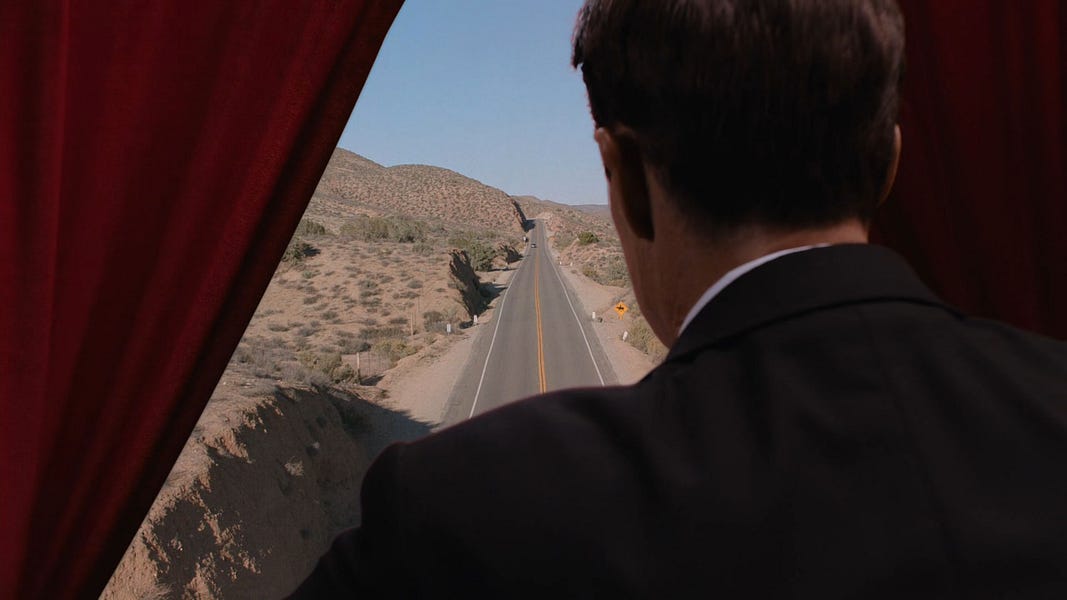
Sacred Sites
I want to consider them as art and as sacred sites, not only because they represent important places in the story, but because there’s a saying that in small towns, “They never put up a stoplight until someone gets killed.” If this is true then stoplights are roadside memorials (and Twin Peaks always foregrounds what’s missing). Then again, these expensive machines are installed in small towns regardless of need all the time because of another saying, that it’s embarrassing to be a one-stoplight town. In a sense, they’re symbols of the unnecessary.
Always signally, floating above us, like planets, apertures; eyeballs; oculi. Cooper in Part 2 opens the curtains of the Red Room and sees a highway from the perspective of a traffic light. Are these devices how the aliens peek in on us? We know that one of their lodge worlds is right above ours.
For fun, my theory is that the traffic light—the one that appears in the pilot before it transitions into Eileen Hayward’s wheelchair—is a person, like the Log, or the Ring, because Twin Peaks is made of “vibrant matter” (Anthony Ballas 2019, 119), everything’s alive and dead, and, as Ryan Coogan (ibid) puts it, “objects act as humans do, humans are often object-like, and there is no distinct hierarchy between the anthropocentric and the inert.”
It’s a person alright, or it’s where someone lives, like Phillip Jeffries. It could also be an extension of someone, and if this is the case then it’s probably the Arm. “Go now!” The Arm seems to be able to travel through electricity (the #6 Telephone Pole could be its gateway) and it controls how people get in and out of the Red Room. A gatekeeper. Interestingly, the pole that supports the head or “signal stack” is called the “arm.”

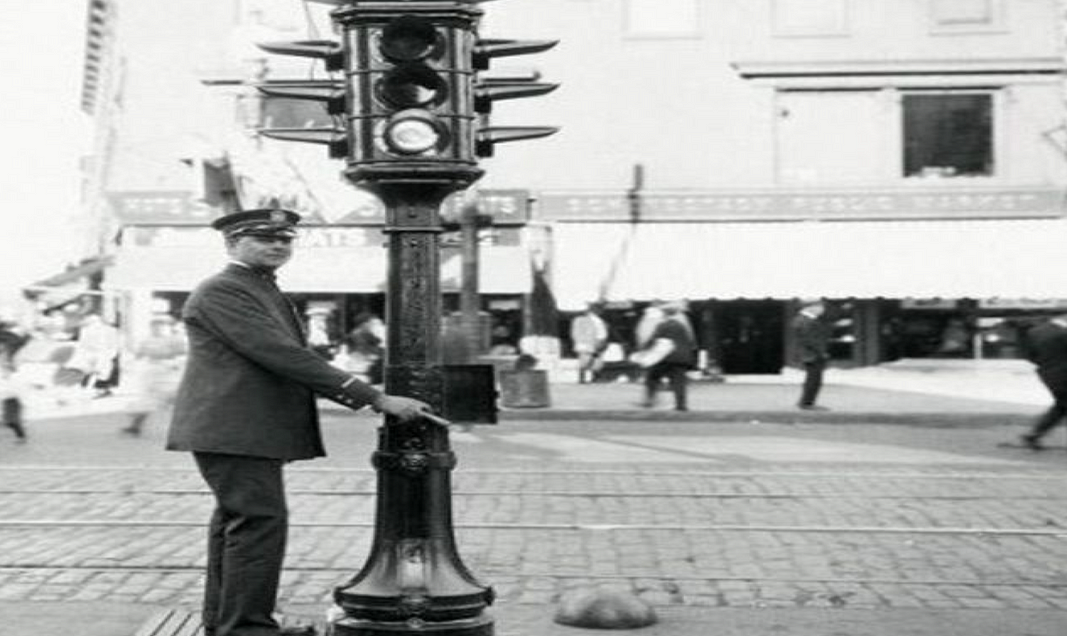
They used to be controlled manually. Now that I think about it, maybe it’s what the Electrician’s been doing, an old-school policeman-wizard who extends into the lights through his cane. His “job” that was decided at the meeting above the convenience store is to control the traffic lights. He looks up and says, “Animal life!”
Who knows? Maybe whoever controls the lights controls the town controls the game.
…Controls who runs into whom.

I’m probably thinking this because hacking traffic lights is a television, film, and video game trope often used to show off someone’s skills (see Mr. C hacking the prison) or just as a way to help the hacker and their buddies escape while their pursuers are stuck in the resulting traffic jams. In real life, traffic lights are sometimes hooked up to the internet and hacked. Also, there is a magical machine called an Opticom that can control traffic signals using blinking lights.
Side note: Some people claim their bodies affect the lights, and they experience “streetlight interference phenomenon” or what’s known as “high voltage syndrome.” We do have a subtle bioelectric charge (and maybe even a sense of being stared at), but I think perceiving or just dreaming of this ability relates to our experience with the buttons installed at intersections that actually do give us this power…or appear to! Most of them don’t work anymore and are placebo buttons! (more Hyperart Thomissons?) Even if they don’t work, they “work” by giving us the illusion of control.
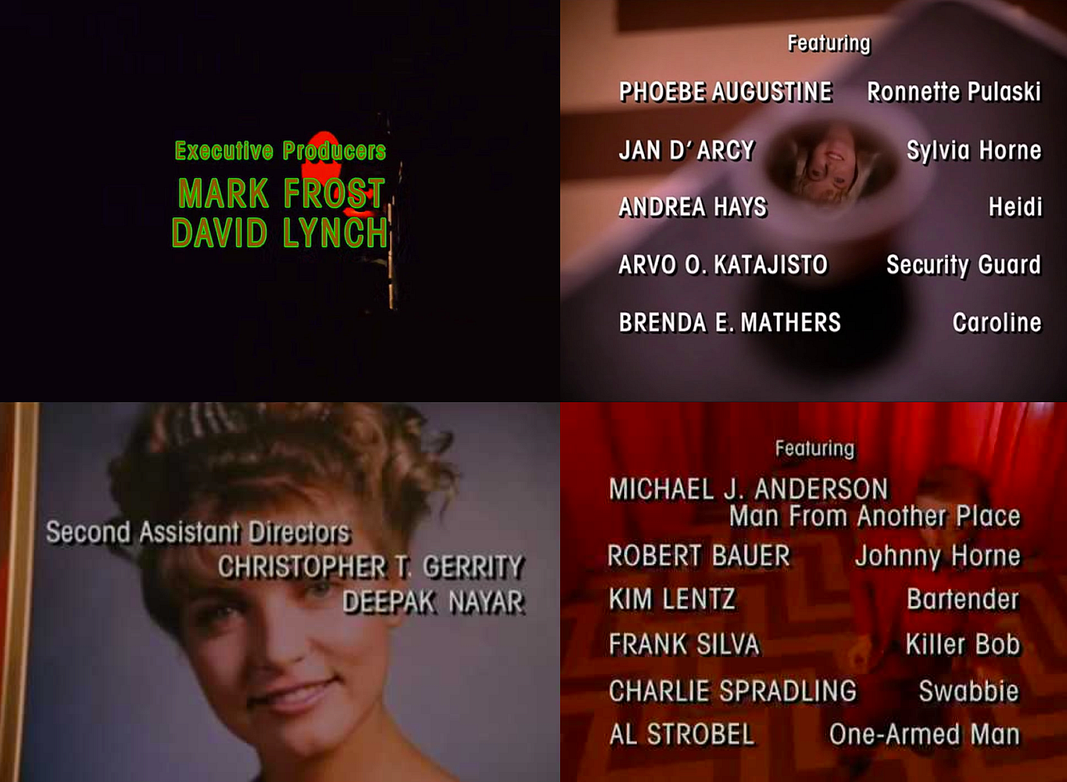
What I’m trying to say is that the traffic light in Twin Peaks is framed to suggest it’s a character involved in the plot. Lynch/Frost don’t have to tell us the whole story. They introduce a panoply of interesting characters, some of them non-human, line ’em up in the imagination, suggest certain relationships and rules, and then let us take it from there. It’s a receptive and creative experience, like a game.
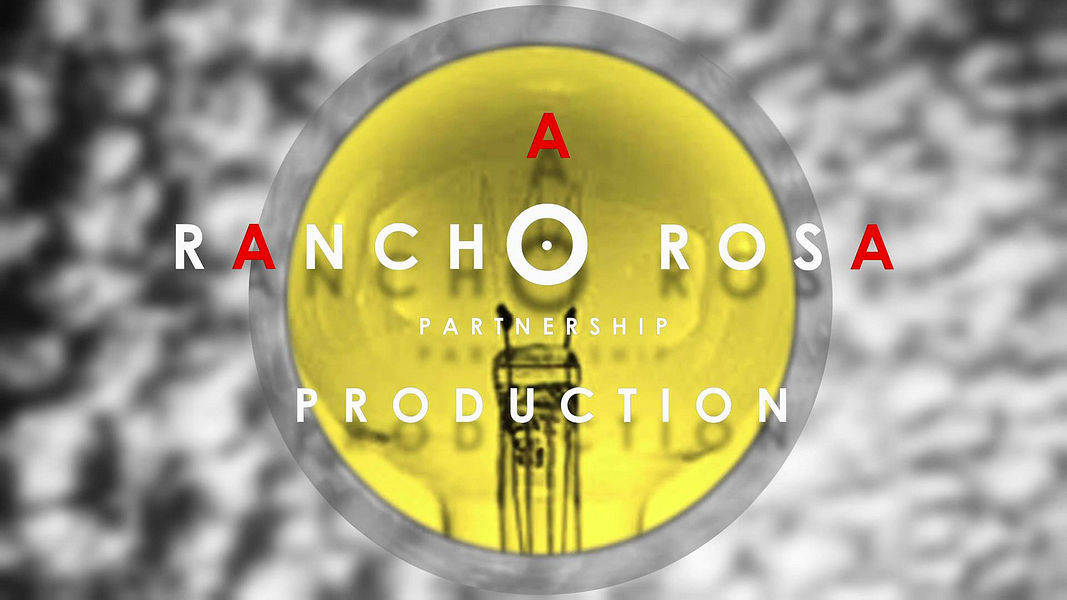
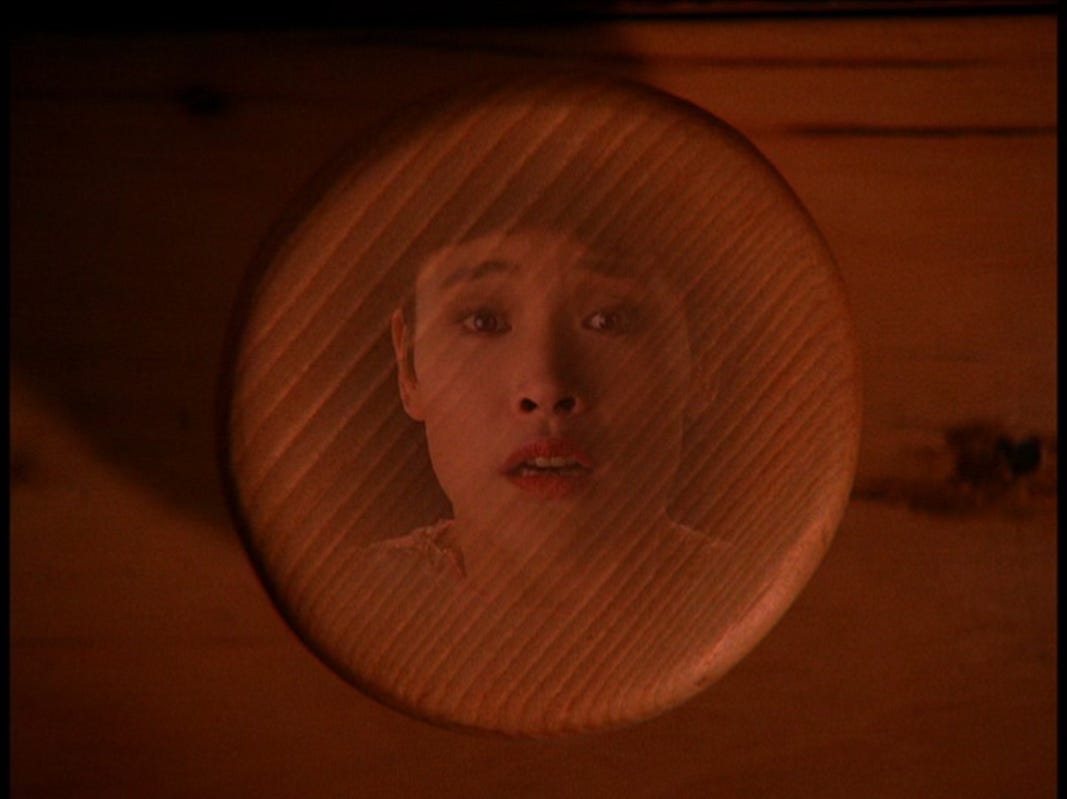
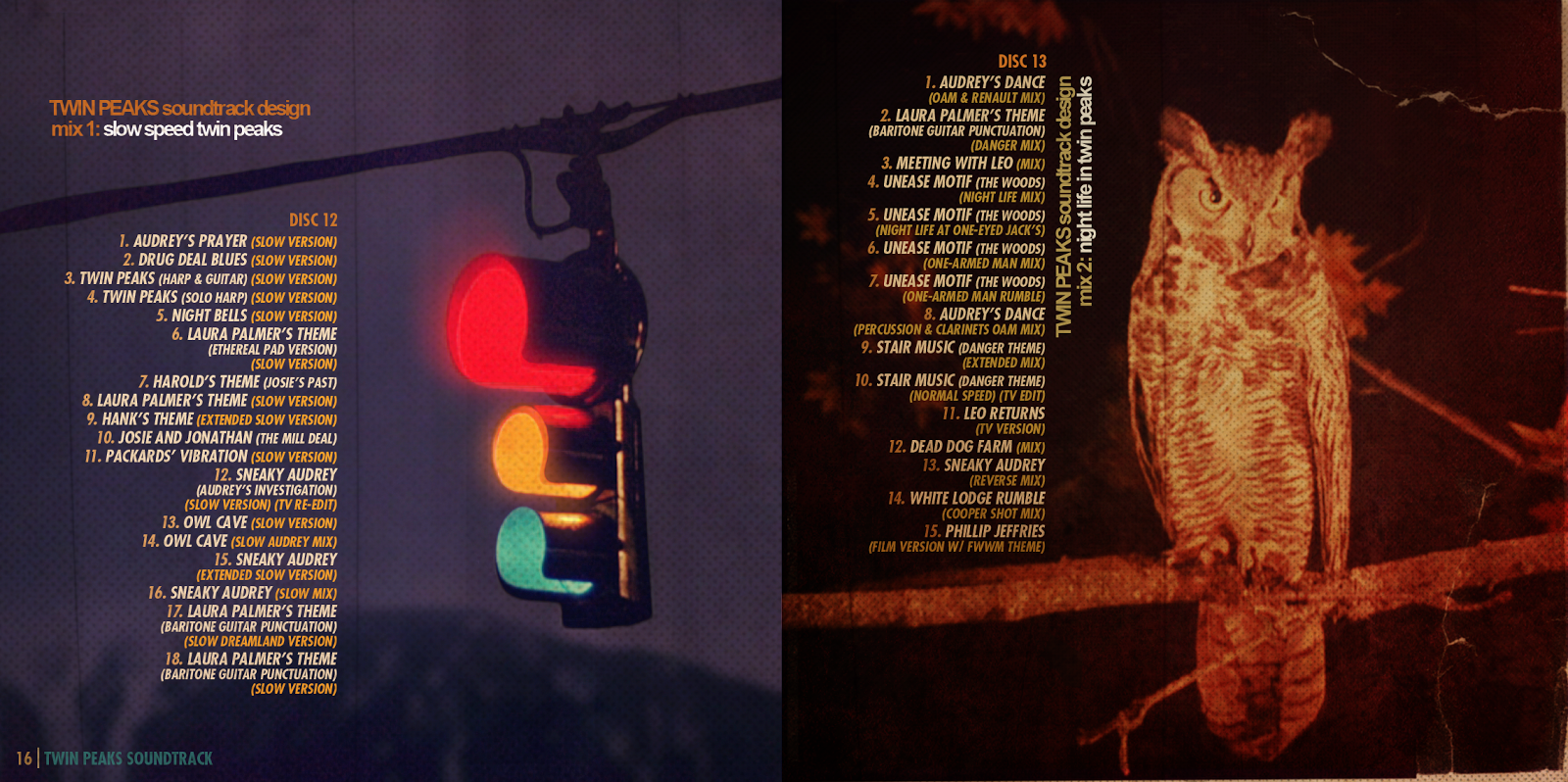
Laura?
There’s a way the traffic light is a person, place, and thing, and sacred site, “and maybe somebody else too!” I like to think it’s somebody else, but a popular fan theory is that the lights are all part of Laura’s elaborate dream world. For some reason, it’s burned into her bardo as a blue key is burned into Dianne Selwin’s bardo.
An ominous machine, hanging there, lynched (it’s about the size of a small person), is seared into her mind, maybe because it was a beacon whenever she snuck out to meet Leo and Jacques for sex (and according to the Secret Diary, she did this a lot). Or maybe it’s there because it was the last sign of life, of hope, that she saw before she died.
Maybe it foreshadows the end of Part 18: back to starting positions; back to red. Or it suggests she’s paranoid the light is watching her like the owls. It’s also likely Laura identifies with it, and it’s a ‘color’ Lynch is using to paint her portrait. Metaphorically (but it’s Twin Peaks so who knows?) a part of Laura is trapped in the traffic light. Fred, from twinpeaksgazette.com, describes this idea beautifully: “The stoplight is all alone, and it carries on going through the motions even when there are no people around. Perhaps this reflects Laura’s loneliness, and her feeling obliged to go through the motions…”
I think what we do as fans is deep map Twin Peaks (William Heat-Moon’s term), “deep mapping” meaning layering the different ways we engage with the characters, symbols and stories, and it’s a living map, always changing. What happens when we begin to think about Laura through the lens of a traffic light? What happens when we think about the entire series through this lens? Or ourselves through the lens of a traffic light? It’s a framework that brings certain aspects of ourselves and the show into focus, especially considering our triune brain functions in a similar way. This reminds me of something that the great Lou Ming says: “As the water falls, it becomes the waving curtains, which become the spinning floor. One idea presented visually in multiple ways, layers of abstraction one upon another until it’s hard to determine which was the original, true image.”
Traffic Peaks
There were cars everywhere!
Does the stoplight reflect the character of the show itself? If it does, Twin Peaks gives us some green and yellow lights, but mostly red lights. It makes us wait. Come to think of it, the pace of the show resembles the pace of a drive. There’s some backing up, accelerating, slowing down, stopping, waiting, starting back up →
There’s also some letting go. The lights are a signal for a type of awareness or experience. Within the millions of cyclopean stoplights floating above our heads, we’ve got three conditions in a loop. There are three lights, three “bodies,” as there are three Coopers, and three Phillips—each assigned to a Cooper—and three Lauras, three seasons, three BOBs according to the Evolution Of The Arm. Also within The Return, we begin and end more or less in the same place.
So too, as the Buddhists would say, every 24 hours, we humans experience three major states of consciousness in a loop; waking, dreaming, and sleeping—three ‘great states’ available to everyone, even babies: You’re mostly in just one at a time — in this case, the waking state with the others pushed into the background—but they’re still there (as are their signature brainwave patterns). Feel them back there? As William James put it a hundred years ago, our normal waking consciousness is but one special type of consciousness, “whilst all about it, parted from it by the filmiest of screens, there lie potential forms of consciousness entirely different.”
At night we fall out of our waking state and start orbiting the dreaming and sleeping states, with waking consciousness waiting just outside that horizon. (Chaos mathemetician Alan Combs speculates that states of consciousness should be conceptualized as chaotic attractors, because when, for example, sleep begins to overtake us, we swiftly drift off as if carried away towards a new “attractor basin.”)
However it happens, the Buddhists point out that falling asleep is also “waking up” to these more subtle states of consciousness. Furthermore, and I hope you don’t mind if I indulge, but Cooper is a Tibetan Dream Yogi and in that system, each of the three great states corresponds with a world or realm—so waking, dreaming, and sleeping states correlate with gross, subtle, and causal realms. Eastern philosophers also point out that “a spectrum of consciousness” is supported by a spectrum of energy that runs from gross physical energy, to etheric/mental/subtle or psychic energy, to causal energy. These energies are also known as bodies or sheaths (because every mind has a body), and every body-mind co-enacts a realm. Therefore, like Dale Cooper, we have three minds, three bodies, and three realms! “I’m a whole damn town!”
Next to all these, there’s a popular Tibetan Buddhist practice called OM, AH, HUM, which imagines the three bodies and energies as colors and sounds stacked on top of each other, going on and off like traffic lights.

For a secular version, you could just use the stoplight colors! Essentially, inside the head, throat, and chest—which correlate to the “three mysteries” body, speech and mind and three energies, gross, subtle and causal, imagine three colored lights: white, red, and blue, and three sounds, OM, AH, and HUM on repeat. To end the meditation, imagine trillions of tiny blue HUMs pouring out of your chest like bubbles touching everything and everyone in the world, turning all into clear blue light.
There are more instructions posted in the end notes. Warning: these maha-mantras, OM, AH, and HUM, can summon very refined impulses of creative intelligence sometimes referred to as angels and devas, so look out! If you imagine tiny versions of your favorite angels floating inside you as the sources of the lights and mantras, they (and their qualities) are more likely going to show up.
This stoplight meditation provides preparation for realization at the time of death, according to Tibetan Buddhist teachers like Khenchen Gyatshen Rinpoche who says:
One experiences many different sensations during the dying process. After the four elements dissolve, the three subtle experiences of white appearance, red increase, and darkness near-attainment occur.
See also Lama Yeshe’s teachings on Om Ah Hung in Life, Death, and After Death, p. 73-83, and I like to remember Cooper’s instructions to Leland in Episode 16 from the Tibetan Book of the Dead: “Your soul has set you face-to-face with the clear light, and you are now about to experience it in all its reality, wherein all things are like the void and cloudless sky, and the naked, spotless intellect is like a transparent vacuum, without circumference or center…
In this moment, know yourself, and abide in that state.
Mandala
The traffic light is not simply a location in space, but also a vehicle in time that can accelerate the evolution of consciousness. That boring minute waiting at a light is a phase-space for watching the “I” get lost in dreams. They hold a mystical potential when considered in this way. Like neon, they reflect qualities of the human condition, maybe even mystical signal stacks. There are fans who chart colors through Twin Peaks like it’s a big painting, and well-armed redditor Bumblewee charts and maps chakra imagery throughout the show, giving us a tour through the many levels of Laura Palmer and the Self which is worth a look.
Conclusions
These manufactured entities are alive and in control. They influence all kinds of non-driving behavior; they cofounded the Manhattan Project, and they’re part of a team of metapersons behind the curtains conjuring other features of our world. Enough people have died, lives ruined, and property damaged that traffic lights are comparable to bombs and demons. In Twin Peaks, it might even be a demon.
More, traffic lights are a positive way into a decentered consciousness and a posthuman, hyperobject, actor-network mindset that’s decolonizing. They’re also interesting containers for visualizing Season 3 as a whole and they help us think about a luminous, ever-changing three-tiered signal stack of dream states happening inside us all the time.
Finally, like any good religious text, Twin Peaks is an eternally recurring stoplight or phase space for probing and synthesizing, waiting, and accelerating. It asks that we consider certain other-than-human objects as significant actors and that we take inventory of inert and ‘dead’ things in our world, too, because they have special agency. Maybe the most obvious example of this is a traffic light, something that literally directs people, like a film director. “Go now! Go now!”

Thank you all so much for your attention! I’d love to hear your thoughts on the traffic light or anything related. Let’s think out loud!
End Notes
The mantras or “mind protectors” Om Ah Hum can be imagined loud and full as a choir, or quiet as a whisper (and everything I know I’m getting from a few different Tibetan teachers and my own experiences). They can even be next-to-nothing proto-sounds. They turn around in the imagined light emanating outward and inward, representing perfect enlightened, ‘diamond’ body, speech, and mind. Some practices involve imagining the lights as tiny humanoid beings—angles, devas, fairies, or even specific people with elaborate details. You can make this thing mythical.
Shift into witnessing or “observer” mode (from that paper on decentered consciousness), set your intentions, and then imagine the white “Om” inside your head, the sanskrit letter if you know it, the romanized sign, or just like a glowing full moon surrounded by space, filling your body up with white light and the imaginary sound “OM” repeating like a broken record for about a minute. Imagine also that this is the “pure body” or perfect body of a Buddha, or whatever archetype you connect with. This practice can be very relaxing and hypnotic, so be sure to let it go.
Take a deep breath and then think of a tiny red light, red like the sun at sunset, and an “A” in the throat, (the first letter, the beginning) along with the sound “AH” imagined as “perfect speech” for about a minute, and then drop down and merge with an imaginary wall-to-wall blue sky and blue star and a “HUM” reverberating in the chest for another minute. Perfect mind. Finally, dissolve the visualization from the outside in, top down, and bottom up, reenacting the process of falling asleep/awake into clear light.
According to Khenchen Rinpoche, to properly dissolve the meditation, imagine “first, the outer universe (which is purified) dissolves into sentient beings. All sentient beings (who are all free from suffering) dissolve into light. That light dissolves into us and we ourselves dissolve into the 3 syllables. Next, the white OM dissolves into the red AH. The red AH then dissolves into the blue HUNG. The blue HUNG dissolves from the bottom up, gradually, into the all-pervading emptiness, which is called the nonobjectified state, free of all boundaries, like the nature of space. That’s the unfabricated state of the mind. Stay in this.” That’s the same state Cooper describes to Leland.
If you want a simple and effective Tantric Buddhist practice, just think the sound Om when you inhale, then think AH when the breath stops, and then think HUM as you exhale. That’s it! The sounds ride the breath. Om Ah Hum, Om Ah Hum, until eventually you just settle on the Ah and grow that inner fire. There is a powerful Japanese Buddhist practice, Ajikan, that only focuses on the A, the mother of all sounds. If you want to add the colors, fill your body with the white light every time you inhale and OM, imagine it blowing on a red flame in your naval, the AH, and then imagine blue HUMs carried out by the exhale into the blue light of all space, “like the void and cloudless sky.”



